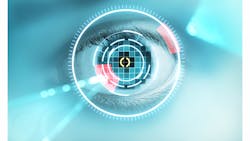Most organizations—whether they are global corporations, small businesses, government agencies, banks, or college campuses—use a variety of traditional methods to secure building access and authenticate identity. But traditional access control approaches, such as security guards, RFID cards, PINs, key badges, and electronic locks, are not meeting today’s increasingly complex and multi-faceted security challenges. As a result, security managers are beginning to explore biometric identification (i.e. fingerprints, voice, and iris recognition), which has proven to be far more reliable than passwords or tokens.
Codes and cards are easily deployed, but they can also be easily lost, forgotten, stolen, or shared. Estimates vary, but simply resetting or replacing passwords and cards can cost between $150 and $200 per employee or customer per year. Badges, pin codes, and even some biometrics solutions can impede the free flow of access for employees, vendors, partners, and customers—negatively impacting productivity and business efficiency.
Even when functioning as intended, traditional access control methods may tell a security manager what has happened in the building (i.e., a badge has been swiped or a pin code has been entered into a door lock), but do not provide certainty that the individual associated with the credential is the person who is actually using it.
Evolving past “contact-intensive” biometrics
The intrusive nature of traditional biometrics solutions—iris recognition in particular—contributes to inefficiencies. Market offerings from security dealers and integrators tend to deliver either speed of access for users or high levels of security, but few deliver both. With typical iris recognition offerings, security and efficiency benefits are offset because user access is impeded by:
- Intrusive, encroaching close-up cameras that require the individual to come in near contact with the device
- The inconvenience of having to slow down and stand still for a scan
- The need to remove all headgear and eyewear for the iris recognition system to get a clean scan
- The requirement for near-ideal environmental conditions (i.e., indoor, well-lit areas)
Benefits of “non-contact” biometrics
Security managers facing diverse access control challenges are looking to dealers and integrators for a best-of-both-worlds iris recognition solution that delivers enhanced security without slowing down the speed businesses need to operate efficiently, securely and cost effectively.
Today’s non-contact iris biometrics solutions eliminate many impediments to free flow access by operating within the natural process people use to enter, traverse and exit facilities. As a result, security dealers and integrators can deliver biometric solutions that provide several key benefits to end users.
Iris recognition is the most reliable form of access control
Impossible to change and almost as difficult to duplicate, human iris patterns are certain and enduring—more than fingerprints, voice, face, or gait. A person’s irises are stable from age 3, and each iris has over 250 points of identification, resulting in one of the lowest false accept rates of any biometric. If two irises are identified, the odds of false accept rate is 1 in over 1 trillion.
This reliability provides a necessary foundation for non-contact biometrics, ensuring that accuracy will remain unmatched relative to other forms of access control—even as irises are scanned outside an individual’s “personal space,” while people are in motion or in unfavorable lighting conditions.
Law enforcement is a sector that depends heavily on reliable and accurate security. For example, every year scores of prisoners are released because of mistaken identity—putting criminals on the streets because of human error. It’s a global issue: the UK Ministry of Justice reports that between 1995 and 2012, one prisoner per week was released by mistake, often for simply having the same name as another inmate. Using iris recognition, prisoners can be immediately identified as they move through the prison from intake to release, ensuring accuracy and officer safety. Errors are eliminated, as iris recognition drastically reduces the chance that the wrong inmate is sent to the infirmary, an outside hospital or the visitor center.
Iris recognition improves speed of access control
Non-contact biometric systems can uniquely identify people in less than a second, and process as many as 30 people per minute. They perform reliable iris scanning even if a user is wearing eyeglasses, contact lenses or most sunglasses, as well as while people are in motion—whether walking through a building turnstile or being transported to an emergency room - and in all lighting conditions.
In emergency care environments, for example, iris recognition could provide critical information before the patient even reaches the ER. As the ambulance travels, EMTs and paramedics can identify patients, gather their medical history, and start procedures and medication right away. And the ability for ambulatory patients to enroll in the iris recognition database during admission is key to accelerating admission and care while maintaining security.
Iris recognition unleashes free flow of access
Knowing an individual’s identity, where they are in a building, and when they arrived or left is critical for security today. This information enables proactive decision-making to permit, exclude or observe an individual in real time. Non-contact iris recognition provides the speed of swiping an access card with the unmatched security of biometrics—all while allowing users to move freely without being conscious of a security procedure at every turn.
Non-contact iris recognition delivers the elusive convergence of speed and security. As security leaders increasingly move beyond traditional access control—and even limited biometrics systems—organizations will increasingly look to security dealers and integrators for offerings that accelerate, rather than inhibit, the free flow of individuals without compromising security.
About the Author: Steve Perna is Executive Director, Products and Services Division at SRI International.


